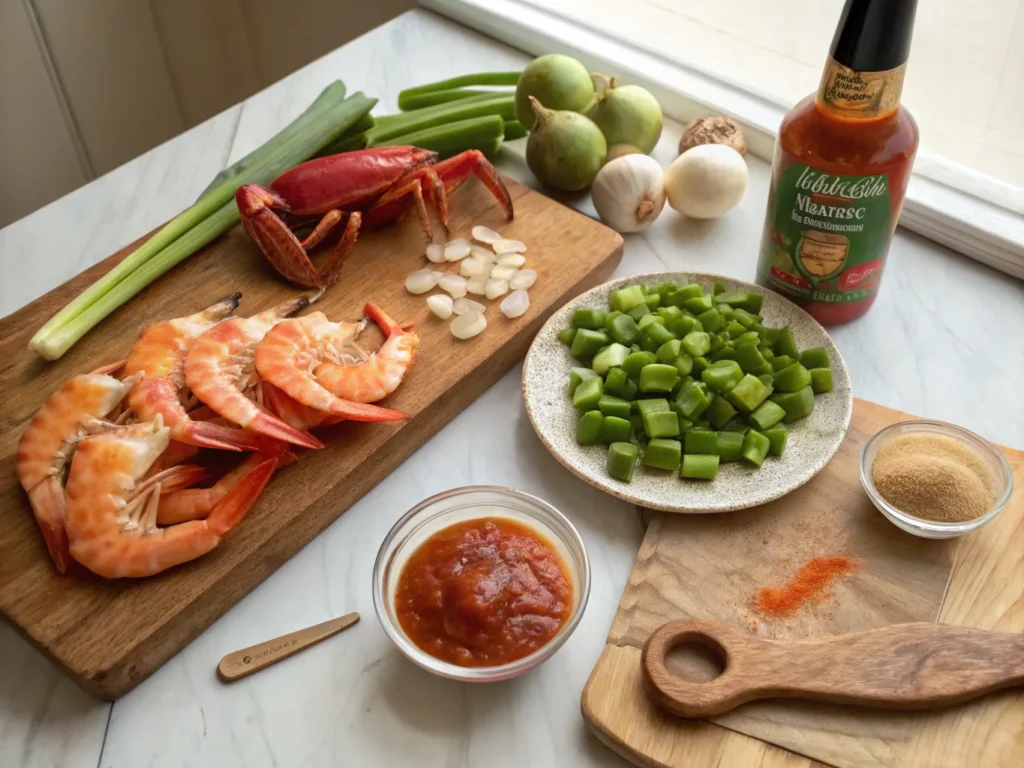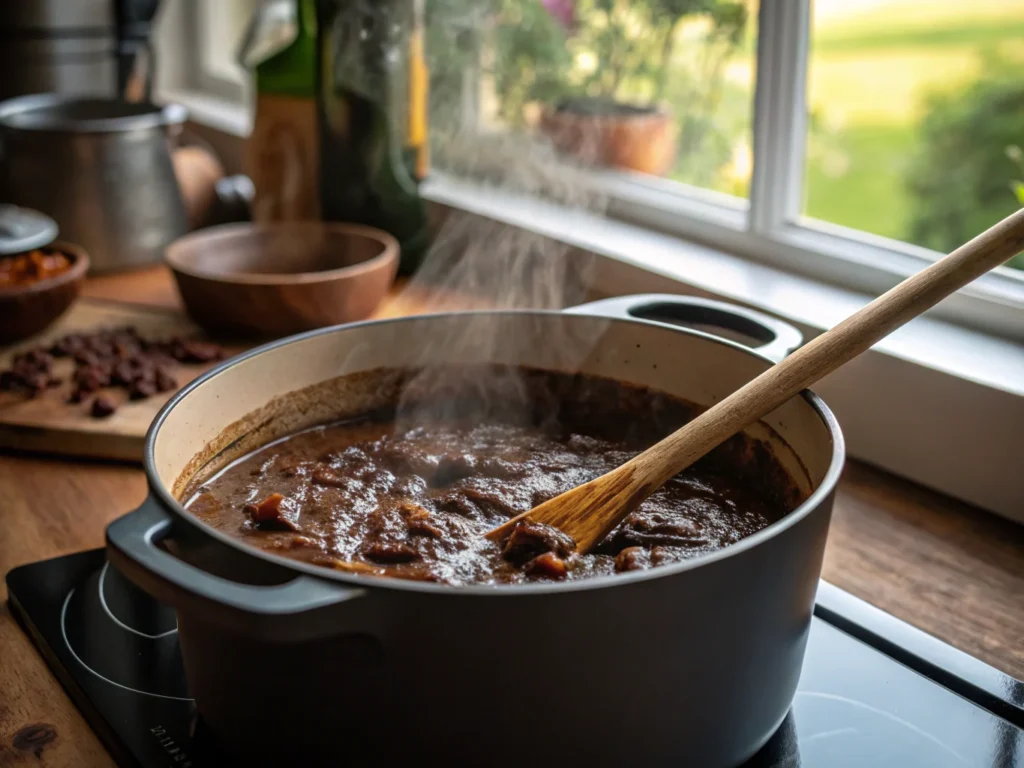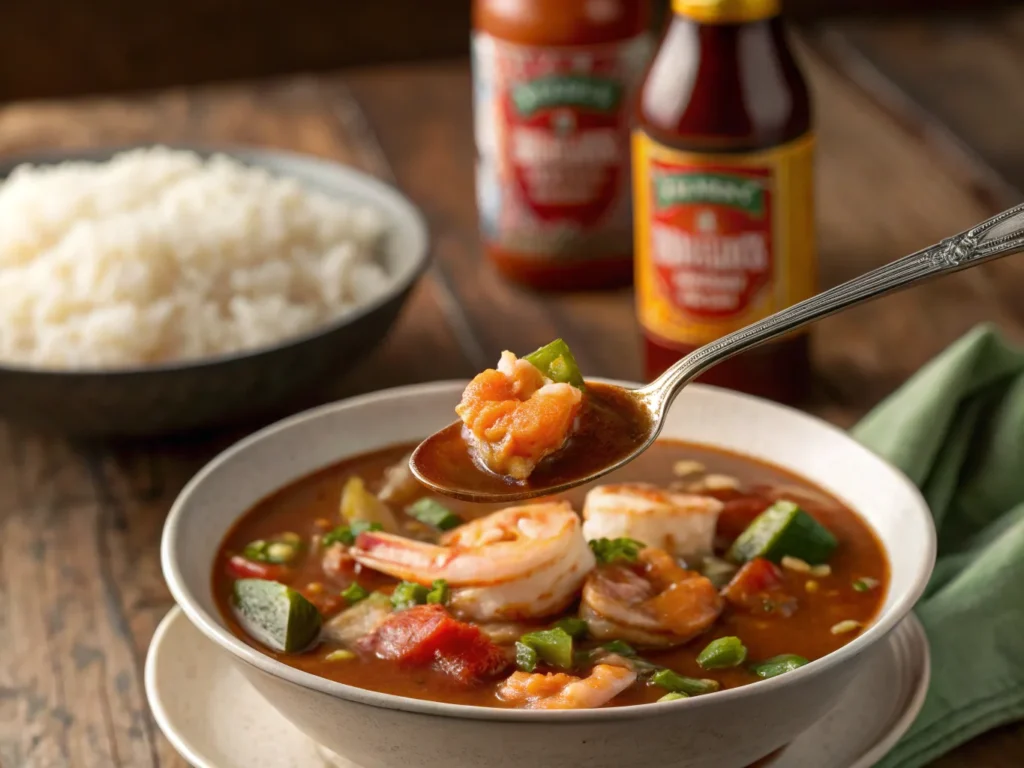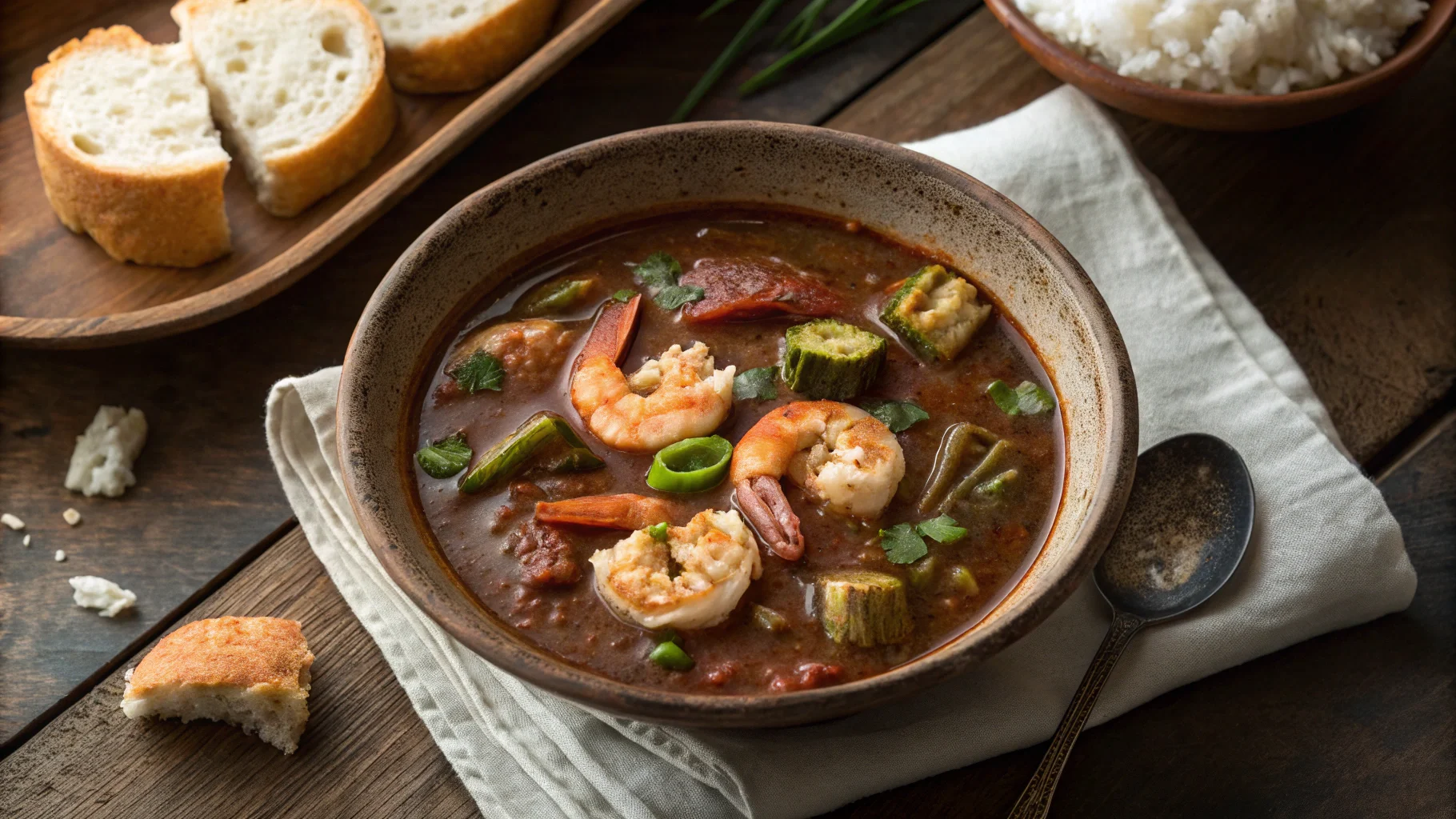Craving authentic Southern cuisine? This Louisiana seafood gumbo recipe is the ultimate comfort food, blending fresh Gulf seafood, bold Cajun spices, and a rich roux into one irresistible dish. Whether you’re a seasoned cook or new to Cajun cooking, this guide will help you craft a flavorful gumbo that’s perfect for any occasion.
In this article, we’ll guide you through every step of making an authentic Louisiana seafood gumbo. From selecting the freshest ingredients to perfecting the roux, you’ll have all the tools you need to serve up a bowl of comfort.
Table of contents
Why This Louisiana Seafood Gumbo Recipe is a Southern Staple
A History of Tradition and Flavor
Gumbo is a cornerstone of Louisiana’s rich culinary heritage, blending African, French, Spanish, and Native American influences. The word “gumbo” comes from the African term for okra, one of the dish’s original thickening agents. Over time, the recipe has evolved, with each family or chef adding their unique twist.
Essential Ingredients for Authentic Louisiana Seafood Gumbo Recipe
The magic of gumbo lies in its ingredients:
- Fresh Seafood: Shrimp, crab, and oysters are popular choices.
- A Perfect Roux: A mixture of flour and fat cooked until dark brown forms the flavorful base.
- Cajun Trinity: Chopped onions, bell peppers, and celery give the dish its signature taste.
- Okra and/or Filé Powder: Both serve as natural thickeners while enhancing the dish’s texture.
Why It’s Loved Across the U.S.
While gumbo is deeply rooted in Louisiana, its hearty, comforting nature has made it a favorite nationwide. It’s not just a meal; it’s a story in a bowl—rich in culture, history, and flavor.
How to Make Louisiana Seafood Gumbo Recipe
Step-by-Step Guide to Cooking a Louisiana Seafood Gumbo
Before diving into the cooking process, it’s crucial to have all your ingredients prepped and ready. Here’s what you’ll need:
- Seafood: 1 pound of shrimp, peeled and deveined; 1 pound of crabmeat; 1 dozen oysters (optional).
- Vegetables: 1 large onion (diced), 1 bell pepper (diced), 2 celery stalks (diced), and 2 cups of okra (sliced).
- Spices and Herbs: 2 teaspoons of Cajun seasoning, 1 teaspoon of thyme, and 2 bay leaves.
- Roux Ingredients: ½ cup of all-purpose flour and ½ cup of vegetable oil.
- Liquid Base: 6 cups of seafood stock or chicken broth.
- Thickener: 1 teaspoon of filé powder (optional).
- Extras: Cooked white rice for serving and chopped green onions for garnish.

Perfecting the Cajun Roux for Your Gumbo Recipe
Make the Roux
The roux is the foundation of any good gumbo. Here’s how to make it perfect:
- Heat the vegetable oil in a large, heavy-bottomed pot over medium heat.
- Gradually whisk in the flour, stirring constantly to avoid burning.
- Cook the mixture for about 20–30 minutes until it turns a deep, chocolate-brown color. This process requires patience and consistent stirring.
Pro Tip: A darker roux adds more depth of flavor but be careful not to burn it!

Add the Cajun Trinity
Once your roux is ready, add the diced onions, bell peppers, and celery to the pot. Sauté the vegetables until they soften and release their aroma, about 5–7 minutes.
Build the Flavor Base
- Stir in the Cajun seasoning, thyme, and bay leaves.
- Gradually add the seafood stock, whisking to combine with the roux.
Bring the mixture to a simmer, then add the sliced okra. Simmer for 15–20 minutes to let the flavors meld.
Learn more about achieving the perfect consistency in dishes with our ultimate guide to pellet grill recipes.
Adding Seafood for the Best Louisiana Gumbo
Add the Seafood
- Add the shrimp first, as they cook quickly (3–5 minutes).
- Gently fold in the crabmeat and oysters, if using. Let the gumbo simmer for an additional 5 minutes.
Pro Tip: Avoid overcooking the seafood to preserve its tender texture.
Final Touches
- Taste and adjust the seasoning with salt, pepper, or extra Cajun spices.
- If desired, sprinkle filé powder into the gumbo to thicken it further and enhance its flavor.
Serve and Enjoy
- Spoon the gumbo over a bed of cooked white rice in a bowl.
- Garnish with chopped green onions for a fresh, bright finish.
Craving more recipes like this? Don’t miss out! Follow Lamyrecipes on Facebook and become part of a community that loves cooking as much as you do!
Looking for seafood inspiration? Try our crab brulee recipe for a unique twist on traditional ingredients.
Tips for Perfecting Your Louisiana Seafood Gumbo Recipe
Secrets to Making a Perfect Roux for Gumbo
The roux is the heart of gumbo, and perfecting it requires a bit of finesse. Here are some tips to ensure yours is flawless:
- Low and Slow is Key: Cook the roux over medium or low heat to avoid burning. A scorched roux can ruin the entire dish.
- Use the Right Tools: A heavy-bottomed pot and a whisk or flat-edged wooden spoon are ideal for consistent stirring.
- Be Patient: Achieving the deep, nutty color takes time—don’t rush it!
How to Select Fresh Seafood for Your Gumbo Recipe
The quality of the seafood can make or break your gumbo. Follow these tips for the best results:
- Shrimp: Opt for wild-caught Gulf shrimp if available. They have a sweeter, more robust flavor.
- Crabmeat: Fresh lump or claw crabmeat works best. If using frozen, thaw it completely and drain excess moisture.
- Oysters: Only add these if you’re a fan of their briny flavor. Fresh oysters are best, but canned oysters can be a substitute in a pinch.
Thickening Your Gumbo
There are two classic ways to achieve gumbo’s signature texture:
- Okra: Adds a natural thickness and a slightly earthy flavor. Be sure to slice it evenly and cook it thoroughly to reduce its slimy texture.
- Filé Powder: Made from ground sassafras leaves, this is added at the end to thicken the gumbo and enhance its flavor.
Pro Tip: Avoid boiling gumbo after adding filé powder, as it can make the dish stringy.
Perfect Pairings: What to Serve with Gumbo
To complete your gumbo meal, consider these classic Southern sides and accompaniments:
- Rice: Steamed white rice is a must-have base for serving gumbo.
- Cornbread: Sweet or savory, cornbread adds a delicious contrast to the spicy gumbo.
- Potato Salad: In some Louisiana households, it’s common to serve potato salad on the side—or even in the gumbo!
- French Bread: Crusty bread is perfect for soaking up every last drop of the flavorful broth.
Storing and Reheating Leftovers
Gumbo is one of those dishes that tastes even better the next day as the flavors meld. Here’s how to store and reheat it properly:
- Refrigeration: Let the gumbo cool to room temperature, then store it in an airtight container. It will keep in the fridge for up to 3 days.
- Freezing: Gumbo freezes exceptionally well. Portion it into freezer-safe containers and store for up to 3 months.
- Reheating: Thaw frozen gumbo in the fridge overnight, then reheat gently on the stovetop over low heat. Add a splash of broth if it has thickened too much.
Exploring Variations and Cultural Significance of Gumbo
The Cultural Significance of Gumbo
Gumbo is more than just a meal—it’s a celebration of Louisiana’s melting pot of cultures. Its origins reflect the influence of African, French, Spanish, and Native American cuisines, each contributing to the dish’s distinct elements. Historically, gumbo has been a communal dish, often served at large gatherings to bring people together.
In Louisiana, gumbo is a symbol of hospitality and tradition. From family recipes passed down through generations to modern twists served in upscale restaurants, gumbo is as much a part of Louisiana’s identity as jazz music and Mardi Gras.

Regional Variations of Louisiana Seafood Gumbo Recipes
Though the base recipe remains similar, gumbo varies depending on the region and available ingredients:
- Creole Gumbo: Features tomatoes, reflecting the French influence on New Orleans cuisine. This version often includes both seafood and sausage.
- Cajun Gumbo: Known for its dark roux and lack of tomatoes, Cajun gumbo is heartier and spicier, often including chicken and andouille sausage.
- Seafood Gumbo: A coastal favorite, this version focuses on shrimp, crab, and oysters, sometimes with okra for thickening.
- Gumbo Z’Herbes: A vegetarian option traditionally made during Lent, featuring a variety of leafy greens like collards, mustard greens, and spinach.
For a taste of international flavors, explore our authentic Gipfeli recipe.
Modern Twists on Traditional Louisiana Seafood Gumbo
Chefs and home cooks alike have put creative spins on gumbo to suit modern tastes or dietary needs:
- Vegan Gumbo: Substitutes meat and seafood with plant-based proteins like jackfruit, tofu, or hearty vegetables.
- Gumbo with Wild Game: Incorporates duck, venison, or even alligator for a more rustic flavor profile.
- Instant Pot Gumbo: A quicker method using an Instant Pot to save time without sacrificing flavor.
Pairing Ideas: Drinks and Desserts
No gumbo meal is complete without the right accompaniments. Here are a few ideas to elevate your dining experience:
- Drinks: Serve with a cold beer, a crisp white wine like Sauvignon Blanc, or a traditional Sazerac cocktail to complement the spices.
- Desserts: Round off the meal with classic Southern treats like pecan pie, bread pudding with bourbon sauce, or beignets dusted with powdered sugar.
Why Gumbo Brings People Together
Gumbo isn’t just about the ingredients; it’s about the experience of sharing a meal. From the aroma that fills the kitchen as it simmers to the lively conversations around the dinner table, gumbo fosters a sense of community. It’s a dish that invites everyone to slow down, savor each bite, and enjoy the company of loved ones.
FAQs
What are the three types of gumbo?
Seafood Gumbo – Made with shrimp, crab, oysters, and other seafood.
Chicken and Sausage Gumbo – Features smoked sausage and chicken.
Vegetarian Gumbo – A plant-based version with vegetables like okra, peppers, and celery.
What are the two rules of gumbo?
Roux Rule – Always use a dark roux as the base for flavor.
Cajun Trinity Rule – Use onions, bell peppers, and celery to build the flavor foundation.
What is the difference between Creole and Cajun gumbo?
Creole Gumbo includes tomatoes and has a lighter flavor, often with seafood.
Cajun Gumbo doesn’t use tomatoes, is heartier, and features more meats like chicken and sausage.
What is the difference between seafood gumbo and regular gumbo?
Seafood Gumbo uses shrimp, crab, oysters, and is lighter in flavor.
Regular Gumbo can include meats like chicken, sausage, or duck, and tends to have a heartier broth.
Conclusion
Louisiana seafood gumbo is more than just a dish—it’s a flavorful journey into the heart of Southern cuisine. From its rich, dark roux to the fresh Gulf seafood and perfectly balanced spices, every bite tells a story of cultural fusion and tradition. Whether you’re making gumbo for a family gathering, a festive occasion, or just to savor a taste of Louisiana, this recipe is sure to deliver.
So grab your ingredients, gather your loved ones, and dive into the process of creating this iconic dish. Once you master the art of gumbo, it’s bound to become a staple in your culinary repertoire!
Louisiana seafood gumbo is more than just a dish—it’s a celebration of flavor and culture. Ready for more inspiring recipes? Join our Facebook community at Lamyrecipes for a treasure trove of delicious recipes, tips, and cooking inspiration!

